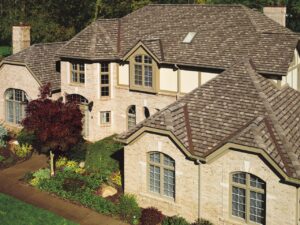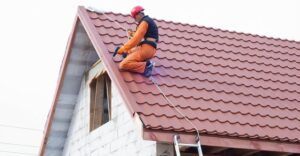Residential roofing protects the structural integrity of a house. It also keeps the indoors regulated and helps to prevent moisture buildup. Various materials are used for residential roofs, each with benefits and drawbacks.
The most common roofing material is asphalt shingles. They are affordable and easy to install. Other options include metal and tile. For more information visit Website.

Asphalt shingles are the most popular roofing material in North America. They are durable, inexpensive, and easy to install. However, they are not infallible. When they’re damaged, they can leak water into the house. This is why it’s important to understand the different types of asphalt shingle damage and what you can do to prevent it.
The basic asphalt shingle comprises three layers: the fiberglass mat, the asphalt, and the granules. The granules give the shingle its color and shading, while the asphalt protects it from sun damage and degradation. The granules also add to the shingle’s traction, which helps it grip the roof and resist wind.
There are two base materials for shingles: organic felt and fiberglass. Organic shingles were the most common roofing material before fiberglass shingles became more widely used. The fiberglass shingles are made from a mat coated with asphalt or impregnated with slate, schist, quartz, vitrified brick, stone, or ceramic granules. The back of the shingle is treated with sand, talc, or mica to keep the shingles from sticking together during manufacturing and storage.
Selecting a quality manufacturer is critical regardless of the type of asphalt shingle you choose. A well-known manufacturer will offer a warranty covering the repair or replacement cost. In addition to the contract, a reputable company will provide a free roof inspection and estimate for any repairs needed.
You can find a variety of colors and styles for asphalt shingles. This makes them a versatile choice for any home design. In addition, they are low maintenance and require no special cleaning or treatments. Some manufacturers even offer shingles that are resistant to algae, which can cause discoloration and staining on the roof.
Some premium asphalt shingles are designed to mimic the look of other roofing materials, such as cedar shakes or slate tiles. These are often called designer shingles and are available in various styles and colors. They are usually more expensive than traditional asphalt shingles, but they can add value to your home and make it stand out in the neighborhood.
Residential roofing is the type of roof that is installed on homes. These roofs are usually designed to be visually appealing and blend in with the home’s architectural style. They are also designed to withstand harsh weather conditions and comply with local building codes. Residential roofs are often designed to be steeper and have more intricate designs than commercial roofs.
Metal is an increasingly popular roofing material. This is mainly because it is very durable and has a long lifespan, but it also offers other benefits. These include:
Steel can be used in various styles, from traditional shingles to standing seam systems. These systems are popular because they offer sleek lines and can be coated in multiple colors, including custom shades. These coatings can also reflect a large amount of sunlight, which can help reduce energy costs.
Another type of metal roofing is called corrugated iron. It is very durable and can be designed to look like shingles or tiles. It can also be painted to match the color of a house. This type of roof is very cost-effective, and it can be easily installed.
Residential metal roofing is more expensive than shingle roofs, but it lasts longer and is more energy efficient. Additionally, it is fireproof and may even lower homeowners’ insurance rates. However, it is important to note that a metal roof requires more maintenance than other types of roofs.
Ask the contractor about their pricing structure if you are considering metal roofing. Typically, they will give you a price for the materials plus labor. This can make it difficult to compare bids accurately.
A residential metal roof can be a good choice if you live in an area with harsh winters. It will protect your home from snow damage and prevent ice dams. Removing snow from a metal roof is easier than from a shingle roof.
It is important to choose the right gauge of metal for your roof. This is because a thinner metal will be less durable and not last as long as a thicker gauge. It would be best always to choose a gauge approved by your local building code.
A tile roof is typically made of terra-cotta, clay, ceramic, or concrete and is hand-laid in rows. Similar to shingles, the tiles overlap one another for a finished look. Tile is known to be a highly durable roofing option that can last for hundreds of years. It is also one of the most cost-effective long-term roofing materials because it insulates a home better.
Unlike asphalt shingles, tile roofs have a higher fire rating and withstand heavier loads. Tile is also available in various styles, textures, colors, and shapes, so it is easier to find something that complements your home’s aesthetic.
It is important to note that although a tile roof is an excellent investment for your home, it can also be a challenge regarding maintenance. It is necessary to inspect your tile roof for cracks or breaks regularly. Additionally, tile is less prone to damage from hail than shingle roofing, but checking your roof after major weather events is still a good idea.
Like any other roofing material, a tile roof can experience color fade over time. However, this usually happens much slower than shingles. Tile roofs can be found in various color options and are often combined with copper for guttering and metal accents to create a more traditional or rustic style.
When choosing a roof, it’s crucial to consider your budget and what kind of aesthetic you want for your house. Shingles are a more affordable and easy-to-install roofing option, while tile is more expensive but lasts longer and is resistant to wind.
Another factor to consider is how long you plan on living in your home. While a tile roof can increase your home value, it’s not necessarily worth the extra expense if you plan on moving in fifteen or thirty years. Lastly, it’s important to consider your HOA’s regulations and requirements, as some will not allow certain types of roofing. This can limit your options when it comes to choosing a new roof.
Wood shakes are a classic roofing option that offers a natural, rustic look for homes. They can withstand most climates and are durable but have some drawbacks.
They require more maintenance and upkeep than other roof types and may not be the best choice for some homeowners. They are vulnerable to pests, mold, and mildew, which can deteriorate the roof’s structure and lead to leaks. They can also rot or become damaged by fire. Because they are made of natural materials, they are less fireproof than other roofing options and are not recommended for homes in wildfire-prone areas.
Shakes are created by splitting wood, which gives them a unique texture and authentic rustic style that many homeowners love. They are also known to last longer than most other roofing materials, with a lifespan of about 30 years under optimal conditions.
However, consider wood shakes as a residential roofing material. In that case, it is important to remember that these shingles tend to warp, which is why using stainless steel fasteners on your roof is recommended. This will help to avoid the need for constant repairs and replacements.
A good residential roofing company will advise you on the type of wood that is best for your home and the climate where it is located so you can decide which roofing material is the right fit for your property. Cedar shakes, for example, are a great choice because they are insect-resistant and have good insulation properties that can help you save money on heating and cooling costs.
Wood shakes are also very eco-friendly, made from recycled materials, and the manufacturers plant new trees to replace those used in production. Additionally, they are a biodegradable and renewable resource, so you can rest assured that if you choose this roofing material for your home, you contribute to preserving the environment. As with any roof, regular inspections are essential to ensure that your wood shake roof is in top condition.
